Density Distribution in Wood of European Birch (Betula pendula Roth.)
Abstract
1. Introduction
2. Materials and Methods
3. Results and Discussion
3.1. Determining the Proportion of Juvenile and Mature Wood
3.2. Wood Density Distribution Analysis
3.3. Density Distribution of Silver Birch Wood on the Cross Section
- ●
- geographical direction (north–south) did not have a statistically significant effect on the distribution of average densities across the entire birch log;
- ●
- distance from the pith had a statistically significant effect on the distribution of average densities across the entire birch log;
- ●
- there was no significant interaction of geographical direction and distance from the pith.
3.4. Density Distribution on the Longitudinal Section of a Birch Log
3.5. Density Map
4. Conclusions
- The place where wood was tested, both in cross-section and longitudinal section of the trunk, had a statistically significant effect on the average density of birch wood.
- The average density of whole logs was statistically significantly higher than the average density at breast height, while the average density at ¼ height did not differ statistically significantly from the average density of the whole log.
- On the cross-section, the distribution of average densities determined at breast height, as well as on ¼ of the log height, properly depicted the distribution of average densities on the cross-section determined for the whole logs. The distribution of average densities in the cross-section can be described by a second degree polynomial in the juvenile wood area and two straight lines (in the mature wood areas); in the juvenile wood area, the average wood density increased significantly along the radius of the tree; in the mature wood areas, there was a slight density fluctuation.
- On the longitudinal section of the tested birch wood, the average density decreased going from the tree butt to 20% of the log height. In the crown area, the average wood density increased as it moved to the top of the tree. In both areas, a statistically significant correlation was obtained between the average density of wood and its location at the height of the trunk.
- The geographical direction (north–south) along which the density was determined did not have a statistically significant effect on the distribution of average densities on the cross-section of the tested birch logs.
Author Contributions
Funding

Acknowledgments
Conflicts of Interest
References
- Niemz, P.; Sonderegger, W. Holzphysik. Physik des Holzes und der Holzwerkstoffe, 1st ed.; Fachbuchverlag Leipzig im Carl Hanser Verlag: München, Germany, 2017; pp. 138–160. [Google Scholar]
- Krzysik, F. Nauka o drewnie, 1st ed.; PWN: Warsaw, Poland, 1957; pp. 615–623. [Google Scholar]
- Kubiak, M.; Laurow, Z. Surowiec Drzewny; Fundacja Rozwój SGGW: Warsaw, Poland, 1994. [Google Scholar]
- Group work under Suwała, M. Poradnik Użytkowania lasu dla Leśników Praktyków (Forest Use Guide for Forestry Practitioners); Oficyna Edytorska Wydawnictwo Świat: Warsaw, Poland, 2000. [Google Scholar]
- Kokociński, W. Drewno: Pomiary Właściwości Fizycznych i Mechanicznych, 1st ed.; Wydawnictwo–Drukarnia Prodruk: Poznań, Poland, 2004. [Google Scholar]
- Bowyer, J.L.; Shmulsky, R.; Haygreen, J.G. Forest Products and Wood Science, an Introduction, 5th ed.; Blackwell Publishing: Ames, IA, USA, 2007. [Google Scholar]
- Giagli, K.; Vavrčík, H.; Fajstavr, M.; Černý, J.; Novosadová, K.; Martiník, A. Stand factors affecting the wood density of naturally regenerated young silver birch growing at the lower altitude of the Czech Republic region. Wood Res. 2019, 64, 1011–1022. [Google Scholar]
- Helińska-Raczkowska, L.; Fabisiak, E. Zależność między długością elementów anatomicznych i gęstością drewna brzozy (Betula pendula Roth.) (Relationship between the length of anatomical elements and the density of birch wood (Betula pendula Roth.). Work Wood Technol. Comm. 1995, 14, 43–48. [Google Scholar]
- Niemz, P. Physik des Holzes und der Holzwerkstoffe; DRW-Verlag Weinbrenner GmbH &. Co.: Esslingen, Germany, 1993. [Google Scholar]
- Fabsiak, E. Zmienność podstawowych elementów anatomicznych i gęstości drewna wybranych gatunków drzew (Variability of basic anatomical elements and wood density of selected tree species). Rocz. Akad. Rol. Pozn. Rozpr. Nauk. 2005, 369, 5–9. [Google Scholar]
- Hakkila, P. Investigations on the basic density of Finnish pine, spruce and birch wood. Commun. Inst. For. Fenn. 1966, 61, 1–98. [Google Scholar]
- Kocoń, J. Struktura i ultrastruktura drewna młodocianego i dojrzałego jodły pospolitej (Structure and ultrastructure of juvenile and mature silver fir). Folia For. Pol. Ser. A 1991, 31, 139–150. [Google Scholar]
- Hejnowicz, Z. Anatomia i Histogeneza Roślin Naczyniowych (Anatomy and Histogenesis of Vascular Plants); PWN: Warsaw, Poland, 1973; Volume 2. [Google Scholar]
- Niedzielska, B.; Wąsik, R. Badania zmienności cech drewna, jako podstawa do racjonalnego kształtowania jego jakości. Stan i perspektywy badań z zakresu użytkowania lasu (Research on variability of wood features as a basis for rational shaping of its quality. The state and perspectives of research on forest use). In Proceedings of the III Forest Conference, Sękocin Las, Poland, 30–31 March 2000; pp. 256–267. [Google Scholar]
- Helińska-Raczkowska, L. Leksykon Nauki o Drewnie (The Lexicon of Wood Science), 1st ed.; Agricultural University of Poznań: Poznań, Poland, 1999; pp. 29–30. [Google Scholar]
- Fukazawa, K. Juvenile wood of hardwoods judged by density variation. IAWA Bull. 1984, 5, 65–73. [Google Scholar] [CrossRef]
- Bao, F.C.; Jiang, Z.H.; Jiang, X.M.; Lu, X.X.; Luo, X.Q.; Zhang, S.Y. Differences in wood properties between juvenile wood and mature wood in 10 species grown in China. Wood Sci. Technol. 2001, 35, 363–375. [Google Scholar] [CrossRef]
- Gryc, V.; Vavrčik, H.; Horn, K. Density of juvenile and mature wood of selected coniferous species. J. For. Sci. 2011, 57, 123–130. [Google Scholar] [CrossRef]
- Kretschmann, D.E. Properties of Juvenile Wood. Techline, Properties and Use of Wood, Composites, and Fiber Products; United States Department of Agriculture, Forest Service, Forest Products Laboratory: Washington, DC, USA, 1998.
- Sobczak, R. Drzewa Naszych Lasów (Trees of Our Forests); Oficyna Edytorska Wydawnictwo Świat: Warsaw, Poland, 1996. [Google Scholar]
- Bernadzki, E.; Kowalski, M. Brzoza na Gruntach Porolnych (Birch on Former Agricultural Lands). Sylwan 1983, 127, 33–42. [Google Scholar]
- Załęski, A. Plantacje Leśnych Drzew Szybko Rosnących (Plantations of Fast-Growing Forest Trees); PWRIL: Warsaw, Poland, 1987. [Google Scholar]
- Godet, J.D. Atlas Drewna. Poradnik Leśnika (Wood ATLAS. Forester’s Guide); Multico Oficyna Wydawnicza: Warsaw, Poland, 2008. [Google Scholar]
- Liepinš, K.; Rieksts-Riekstinš, J. Stemwood density of juvenile silver birch trees (Betula pendula Roth.) from plantations on former farmlands. Balt. For. 2013, 19, 179–186. [Google Scholar]
- Viherä-Aarnio, A.; Velling, P. Growth, wood density and bark thickness of silver birch originating from the Baltic countries and Finland in two Finnish provenance trials. Silva Fenn. 2017, 51, 18. [Google Scholar] [CrossRef]
- Herujarvi, H. Variation of basic density and brinell hardness within mature Finnish Betula pendula and B. pubescens stems. Wood Fiber Sci. 2004, 36, 216–227. [Google Scholar]
- Krzosek, S. Badanie Gęstości, jako Kryterium Wytrzymałościowej Jakości Iglastej Tarcicy Konstrukcyjnej (Density Testing as a Criterion for Strength Quality Coniferous Structural Timber). Ph.D. Thesis, Warsaw University of Life Sciences, Warsaw, Poland, 1998. [Google Scholar]
- Elandt, R. Statystyka Matematyczna w Zastosowaniu do Doświadczalnictwa Rolniczego (Mathematical Statistics in Application to Agricultural Experimentation); PWN: Warsaw, Poland, 1964. [Google Scholar]
- Wagenführ, R.; Scheiber, C.H.R. Holzatlas. Mit 890 zum Teil Mehrfarbigen Bilden; VEB Fachbuchverlag: Leipzig, Germany, 1985. [Google Scholar]
- Kokociński, W. Anatomia Drewna (Anatomy of Wood); Drukarnia Prodruk: Poznań, Poland, 2005. [Google Scholar]
- Galewski, W.; Korzeniowski, A. Atlas Najważniejszych Gatunków Drewna (Atlas of the Most Important wood Species); PWRIL: Warsaw, Poland, 1958. [Google Scholar]
- Abdel-Gadir, A.Y.; Krahmer, R.L. Estimating the age of demarcation of juvenile and mature wood in Douglas-fir. Wood Fiber Sci. 1993, 25, 242–249. [Google Scholar]
- Stanisz, A. Przystępny kurs Statystyki z Zastosowaniem STATISTICA PL na Przykładach z Medycyny. Tom 2. Modele Liniowe i Nieliniowe (An Affordable Statistics Course Using STATISTICA PL on Examples from Medicine. Volume 2. Linear and Nonlinear Models); StatSoft Polska Sp. z o.o.: Kraków, Poland, 2007. [Google Scholar]
- Bonham, V.A.; Barnett, J.R. Fibre length and microfibril angle in silver birch (Betula pendula Roth). Holzforschung 2001, 55, 159–162. [Google Scholar] [CrossRef]
- Helińska-Raczkowska, L.; Fabisiak, E. Długość młodocianego okresu przyrostu na grubość drzew brzozy (Betula pendula Roth.) (Length of adolescent growth in birch trees (Betula pendula Roth.)). Sylwan 1995, 139, 77–84. [Google Scholar]
- Hakkila, P. Wood density survey and dry weight tables for pine, spruce and birch stems in Finland. Commun. Inst. For. Fenn. 1979, 96, 1–59. [Google Scholar]
- Pazdrowski, W. Wartość techniczna drewna sosny zwyczajnej (Pinus Sylvestris L.) w zależności od jakości pni drzew w drzewostanach rębnych (Technical value of Scots pine (Pinus Sylvestris L.) wood depending on the quality of tree trunks in forest stands). Rocz. Akad. Rol. Pozn. Rozpr. Nauk. 1988, 170. [Google Scholar]
- Velling, P. Wood density in two Betula pendula Roth progeny trials. Folia For. 1979, 416, 1–24. [Google Scholar]
- Niedzielska, B. Zmienność gęstości oraz podstawowych cech makroskopowej struktury drewna jodły (Abies alba Mill.) w granicach jej naturalnego występowania w Polsce (Variability of density and basic features of the macroscopic structure of fir wood (Abies alba Mill.) Within its natural occurrence in Poland). Zesz. Nauk. Akad. Rol. Kołłątaja Krakowie 1995, 198, 1–75. [Google Scholar]
- Miler, Z. Badania nad własnościami drewna brzozy brodawkowatej i omszonej (Research on the properties of birch wood). Folia For. Pol. Ser. B 1966, 7, 135–159. [Google Scholar]


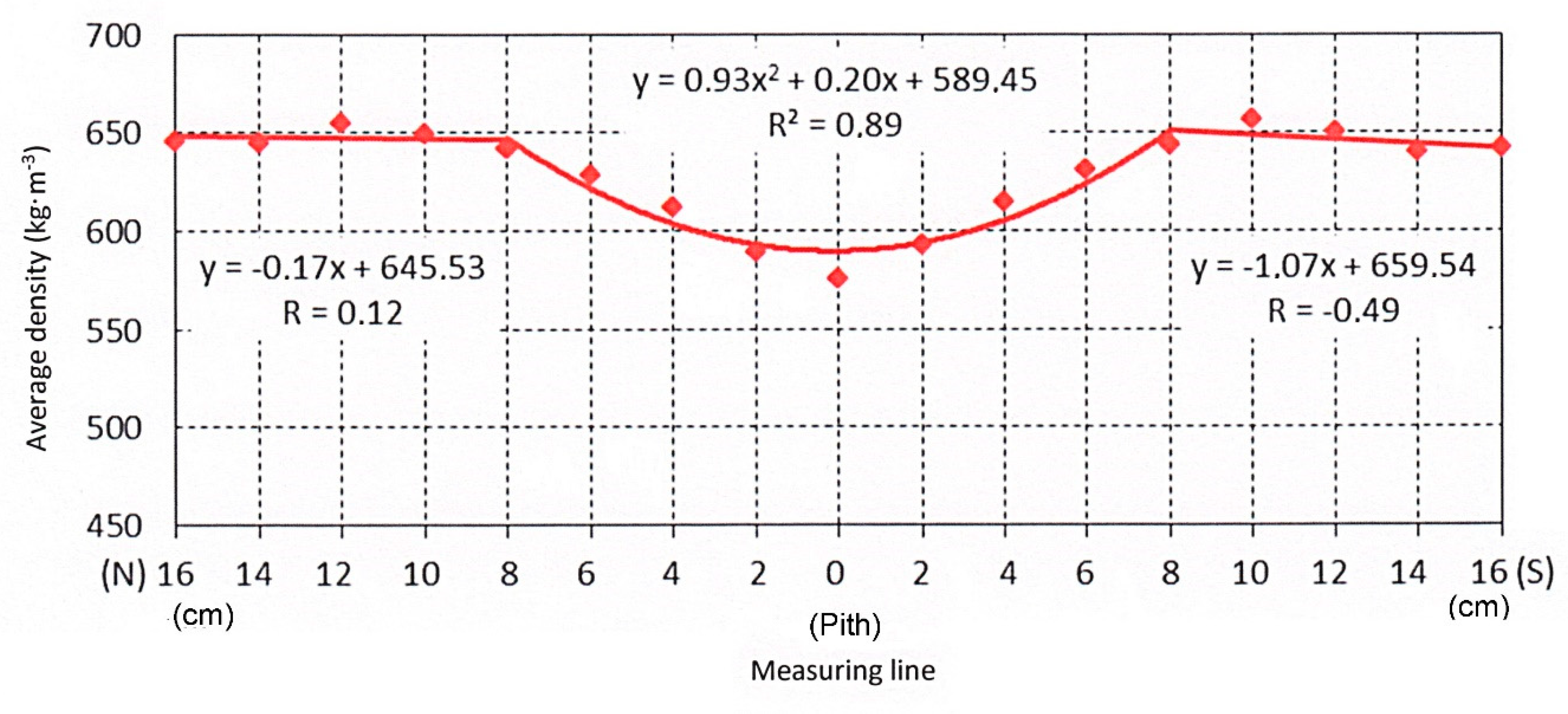

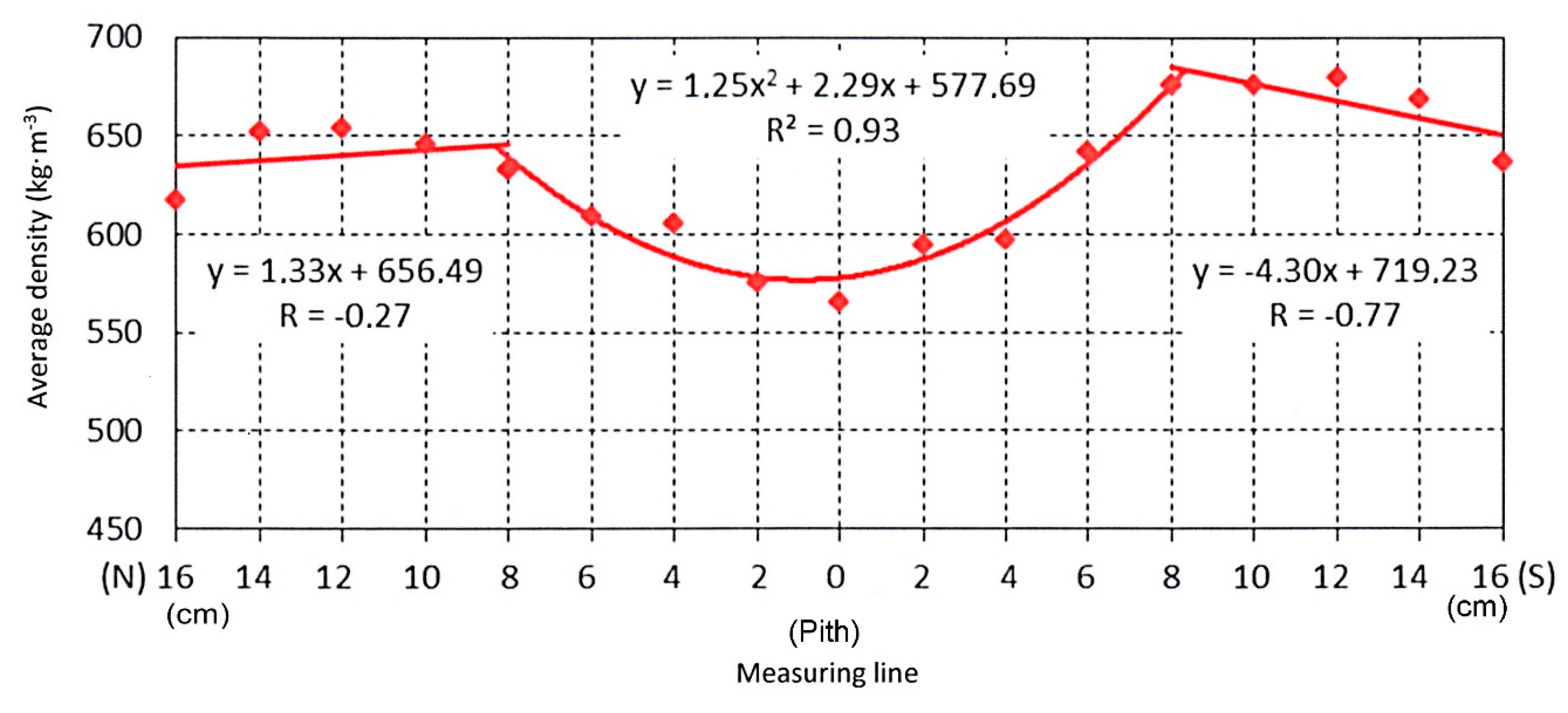
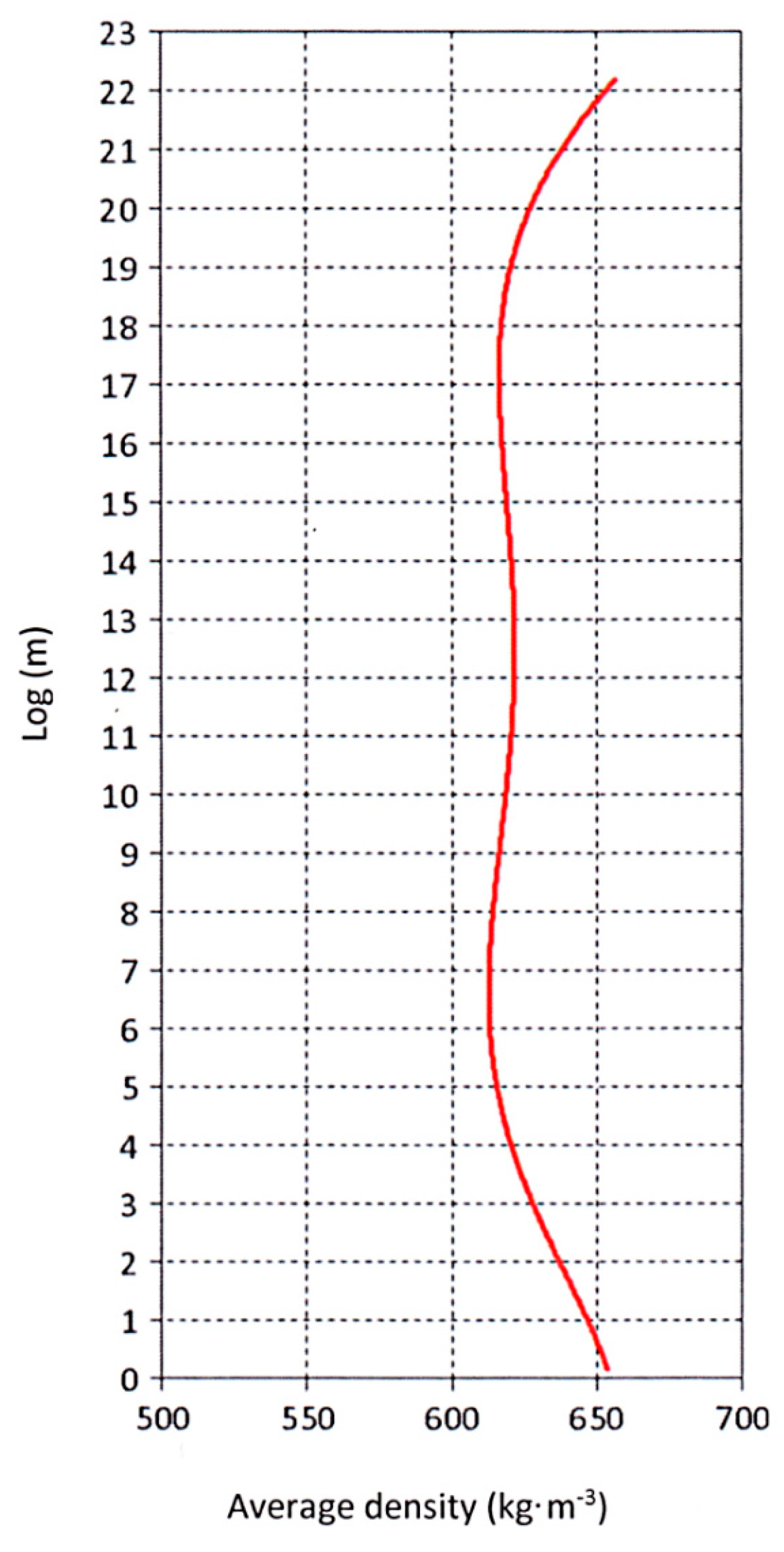
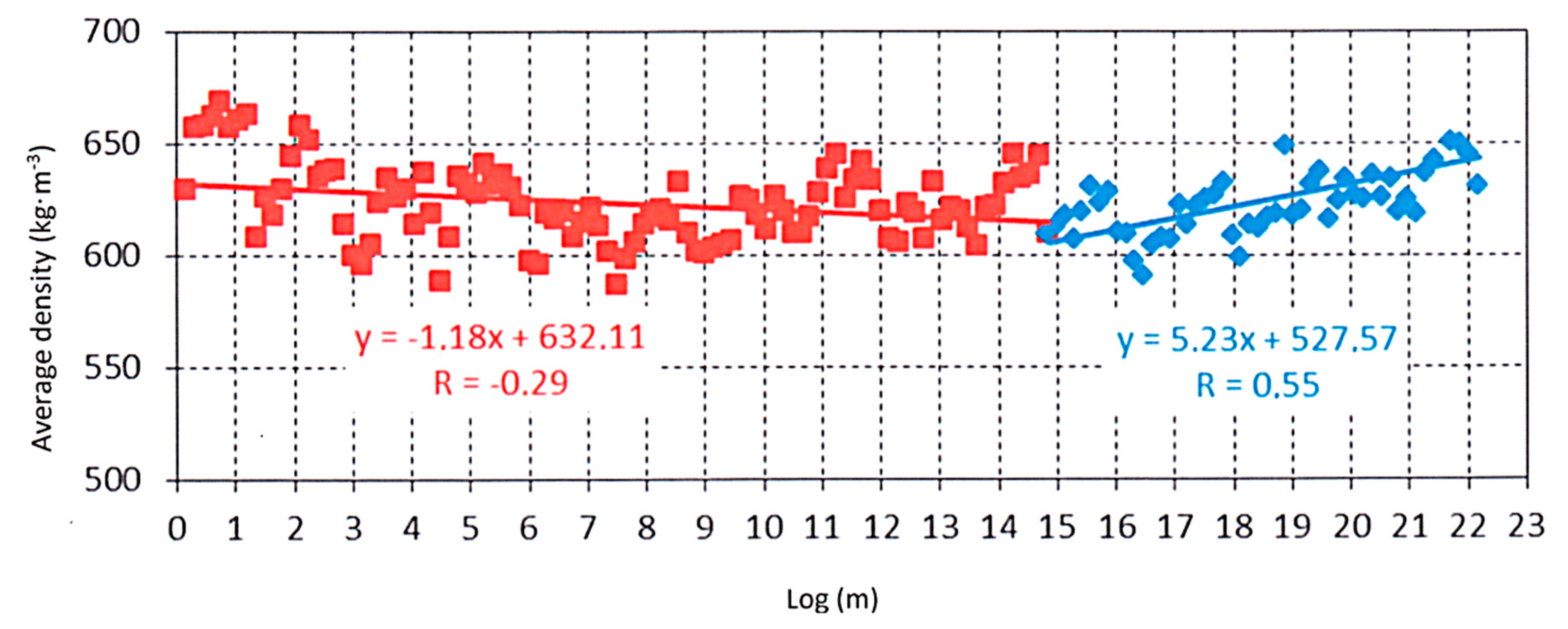
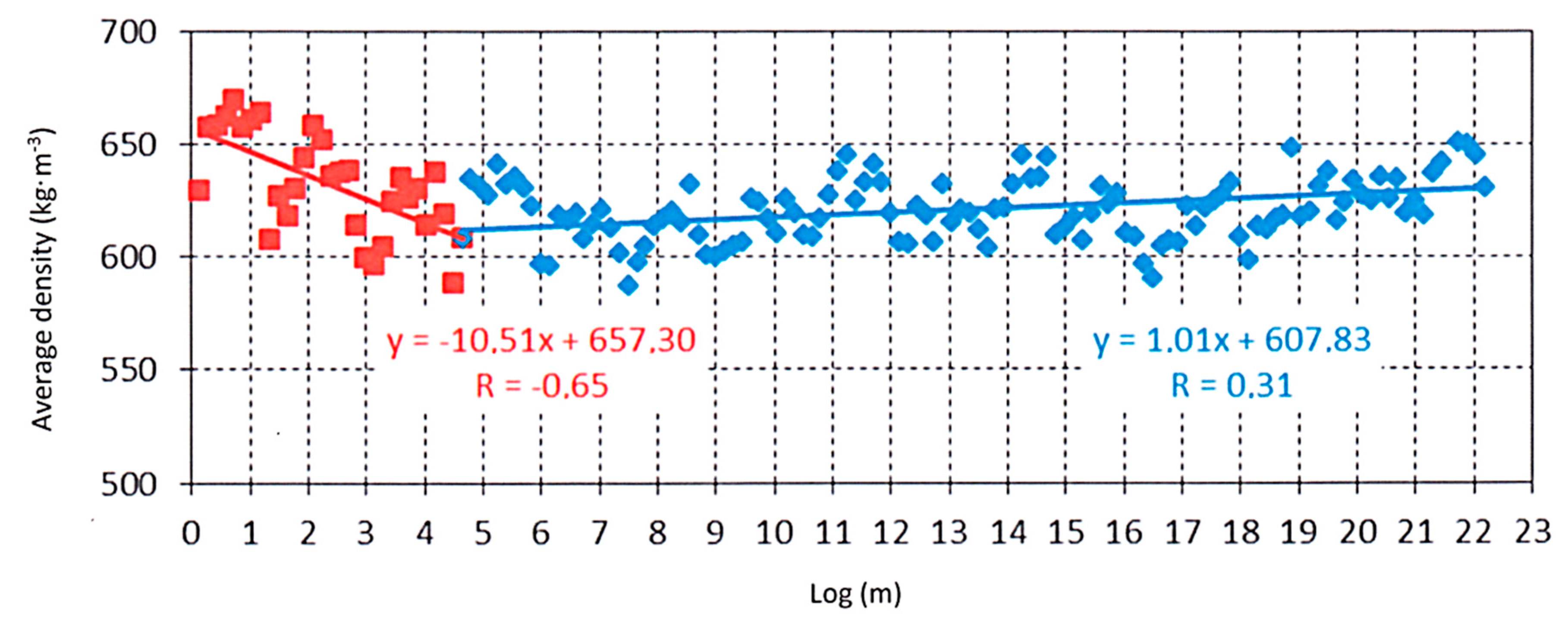
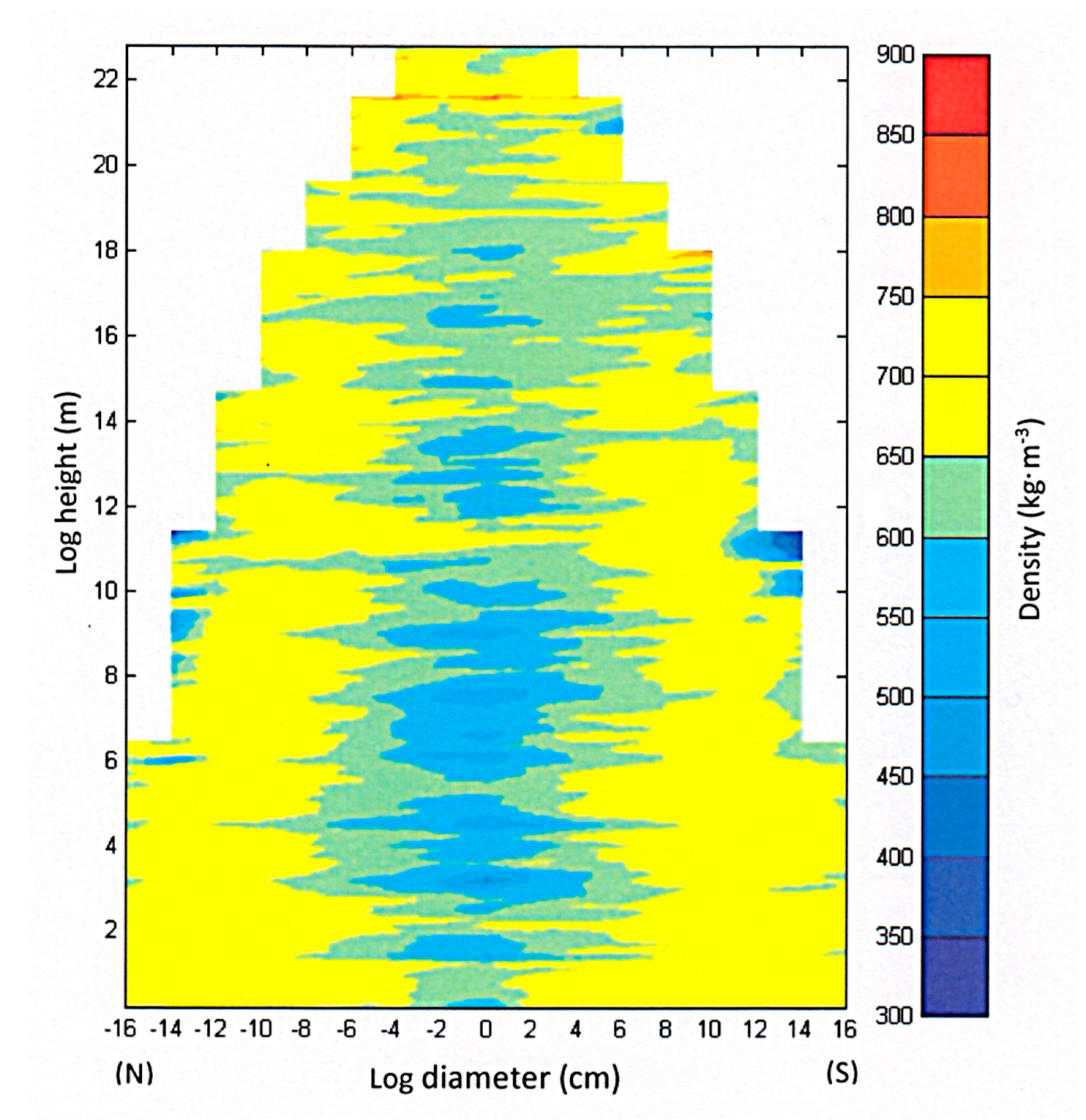
| Feature | Log Number | ||||
|---|---|---|---|---|---|
| I | II | III | IV | V | |
| Age * (years) | 71 | 72 | 72 | 70 | 70 |
| Diameter at breast high in bark (cm) | 42 | 42 | 42 | 42 | 42 |
| High (m) | 22.8 | 21.5 | 22.0 | 21.5 | 21.5 |
| Crown index ** | 0.3 | 0.3 | 0.3 | 0.3 | 0.3 |
| Feature | Value |
|---|---|
| Average width | 2.6 mm |
| Coefficient of variation | 47% |
| Minimal width | 0.4 mm |
| Maximal width | 6.5 mm |
| Average number of annual rings | 68 |
| Feature | Value |
|---|---|
| Average length | 1279 μm |
| Coefficient of variation | 20% |
| Minimal length | 440 μm |
| Maximal length | 2032 μm |
| Number of measurements | 1380 |
| Density | |
|---|---|
| Average density (kg/m3) | 623 |
| Standard deviation (kg/m3) | 58 |
| Variability coefficient (%) | 9.3 |
| Average density at breast high (kg/m3) | 608 |
| Average density at ¼ high of the log (kg/m3) | 630 |
| Minimal value of density (kg/m3) | 318 |
| Maximal value of density (kg/m3) | 895 |
| Difference between maximal and minimal value of density (kg/m3) | 577 |
| Number of measurements | 8320 |
| Parameter | Empirical Statistics t | Critical Statistics t0.05/2; v | Number of Degrees of Freedom v |
|---|---|---|---|
| Average density of all logs/Average density at breast height | 2.413 | 1.960 | 8401 |
| Average density of all logs/Average density at ¼ high of the log | 0.860 | 1.993 | 73 |
| Source of Variation | Sum of Squared Deviations | Number of Degrees of Freedom | The Mean Square of Deviations | Empirical Statistics F | Test Probability p |
|---|---|---|---|---|---|
| Intercept | 2,039,755,000 | 1 | 2,039,755,000 | 784,716 | 0.000 |
| Geographical direction | 299 | 1 | 299 | 0.115 | 0.735 |
| Distance from the core | 3,709,976 | 7 | 529,997 | 203.896 | 0.000 |
| Direction⋅Distance | 22,208 | 7 | 3173 | 1.221 | 0.287 |
| Error | 19,786,270 | 7612 | 2599 | - | - |
| Distance from the Core (cm) | Average Density (kg/m3) | Test Probability p | |||||||
|---|---|---|---|---|---|---|---|---|---|
| 2 | 4 | 6 | 8 | 10 | 12 | 14 | 16 | ||
| 2 | 591 | 0.000 | 0.000 | 0.000 | 0.000 | 0.000 | 0.000 | 0.000 | |
| 4 | 613 | 0.000 | 0.000 | 0.000 | 0.000 | 0.000 | 0.000 | 0.000 | |
| 6 | 630 | 0.000 | 0.000 | 0.000 | 0.000 | 0.000 | 0.000 | 0.004 | |
| 8 | 643 | 0.000 | 0.000 | 0.000 | 0.000 | 0.004 | 1.000 | 1.000 | |
| 10 | 653 | 0.000 | 0.000 | 0.000 | 0.000 | 1.000 | 0.007 | 0.289 | |
| 12 | 653 | 0.000 | 0.000 | 0.000 | 0.004 | 1.000 | 0.026 | 0.411 | |
| 14 | 643 | 0.000 | 0.000 | 0.000 | 1.000 | 0.007 | 0.026 | 1.000 | |
| 16 | 644 | 0.000 | 0.000 | 0.004 | 1.000 | 0.289 | 0.411 | 1.000 | |
| Homogeneous group number | 1 | 2 | 3 | 4 | 5 | 5 | 4 | 4. 5 | |
| Area Type | Correlation Coefficient R | Critical Values R0.05/2; v; k+1 | Number of Degrees of Freedom v |
|---|---|---|---|
| Distribution at breast height | 0.977 | 0.666 | 7 |
| Distribution at ¼ of the height of the log | 0.959 | 0.666 | 7 |
| Area Type | Radial Density Increase (%) |
|---|---|
| All logs | 11.9 |
| At breast height | 17.7 |
| At ¼ of the height of the log | 15.9 |
| Empirical Statistics F | Critical Statistics F0.05; u; v | Number of Degrees of Freedom u, v |
|---|---|---|
| 5.602 | 1.202 | 147. 8172 |
| Area Type | Correlation Coefficient R | Critical Values R0.05/2; v; k+1 | Number of Degrees of Freedom v |
|---|---|---|---|
| From the butt to the base of the crown | −0.291 | 0.198 | 97 |
| Between the base of the crown and the top of the tree | 0.551 | 0.279 | 48 |
| Area Type | Correlation Coefficient R | Critical Values R0.05/2; v; k+1 | Number of Degrees of Freedom v |
|---|---|---|---|
| Below 0.2 log height | −0.649 | 0.355 | 29 |
| Above 0.2 log height | 0.306 | 0.182 | 116 |
| Feature | ||
|---|---|---|
| Average density (kg/m3) | 623 | |
| The proportion of average results of density measurements in density ranges | Density ranges (kg/m3) | Proportion (%) |
| 0–99.9 | 0.0 | |
| 100–199.9 | 0.0 | |
| 200–299.9 | 0.0 | |
| 300–399.9 | 0.3 | |
| 400–499.9 | 0.7 | |
| 500–599.9 | 22.3 | |
| 600–699.9 | 75.4 | |
| 700–799.9 | 1.3 | |
© 2020 by the authors. Licensee MDPI, Basel, Switzerland. This article is an open access article distributed under the terms and conditions of the Creative Commons Attribution (CC BY) license (http://creativecommons.org/licenses/by/4.0/).
Share and Cite
Dobrowolska, E.; Wroniszewska, P.; Jankowska, A. Density Distribution in Wood of European Birch (Betula pendula Roth.). Forests 2020, 11, 445. https://doi.org/10.3390/f11040445
Dobrowolska E, Wroniszewska P, Jankowska A. Density Distribution in Wood of European Birch (Betula pendula Roth.). Forests. 2020; 11(4):445. https://doi.org/10.3390/f11040445
Chicago/Turabian StyleDobrowolska, Ewa, Paulina Wroniszewska, and Agnieszka Jankowska. 2020. "Density Distribution in Wood of European Birch (Betula pendula Roth.)" Forests 11, no. 4: 445. https://doi.org/10.3390/f11040445
APA StyleDobrowolska, E., Wroniszewska, P., & Jankowska, A. (2020). Density Distribution in Wood of European Birch (Betula pendula Roth.). Forests, 11(4), 445. https://doi.org/10.3390/f11040445







